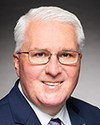Madam Speaker, I will be sharing my time with the member for Brantford—Brant.
I will start off by thanking the member for Edmonton—Wetaskiwin for his work and advocacy with respect to autism. I believe this is the first time the Parliament of Canada has dedicated a full day to a discussion regarding autism in this country. This truly is a historic day.
Autism affects more than 500,000 Canadians. I want to spend my time today talking about the principles of the Canadian autism project, about helping families who are dealing with autism not just in Ontario but right across the country.
It is important that we look at the principles of the Canadian autism project. There are five listed in the report, which states that all Canadians living with autism have the right to inclusion, understanding, and acceptance; respect and dignity; full citizenship; equitable opportunities and access; and personal autonomy and decision-making.
We are very lucky to be here in Canada where acceptance of differences in Canadians is a trait that we celebrate and practise every day. It is important that government do its part to foster this acceptance. The Canadian autism project, or CAP for short, has brought major stakeholders together to share ideas and practices that will benefit the education and life-learning skills that take longer to learn for those children who have autistic spectrum disorder, simply known as ASD.
The origins of CAP go back to budget 2015 under Prime Minister Harper, which brought the CAP working group together to deliver a report to take action on ASD. The initial budget offered $2 million. Following the delivery of this report last fall, there was an ask to fund the project further. In the 2017 Liberal budget, the Minister of Finance and the government ignored that request. CAP was asking for $19 million.
Let us look at the five principles to try to make some sense of it all for the government, and to persuade some members on the Liberal backbenches to support the motion and help Canadian families who live with ASD in their homes.
The first principle refers to Inclusion, understanding, and acceptance. As I said, half a million Canadians are living with ASD. Each one of those Canadians is an individual who has his or her own personality, interests, talents, and most important, tremendous potential. I cannot overstate the importance that each Canadian with ASD is given every opportunity for that potential. Sadly, this is not the case across the country because, depending on the province one lives in, the diagnosis, treatment, and potential for each child differs.
In Ontario, intensive behavioural intervention therapy, IBI therapy, for children over five was eliminated, leaving thousands of families struggling to get the treatment they need. There needs to be an understanding at every level of government about the needs of the children and families when it comes to the diagnosis and treatment of ASD.
The second principle of CAP is one of respect and dignity. Living with ASD is not easy on the family, and especially on the child who has been diagnosed. Life is different for those who have ASD. Between 50% and 70% of those with ASD will have a mental health condition. To have ASD also means that the child may not understand what is happening to him or her or know how to compensate or handle it. Making sure there is proper treatment across Canada would help ensure that those children would have the sense of dignity that most Canadians feel.
The third principle is full citizenship. For Canadians, full citizenship means that every person should have access to all of the services available for a correct diagnosis, for treatment, and for the best possible life. The cost of caregiving for a child with ASD is up to $5.5 million. All levels of governments need to work together to provide education, health care, and potential, three things that every parent expects his or her child to have access to.
The fourth principle as noted in the CAP report is equitable opportunities and access. The principle is demonstrated with the Canadian autism partnership vision statement, which states:
All Canadians living with Autism have the opportunity to lead fulfilling and rewarding lives, and are able to access the necessary supports and services in a welcoming and understanding society.
Autism is the fastest growing diagnosed neurological disorder in Canada. There has been a 100% increase in positive diagnoses in 10 years. One in 68 children is now living with ASD, up from one in 190. Boys are now five times more likely than girls to be diagnosed. In Ontario, in 2016, there was a wait-list of 2,192 people for intensive behavioural intervention, and almost 14,000 for applied behavioural analysis.
What CAP is going to do is create a national platform for multi-sectoral collaboration and innovation to drive systemic change. The CAP approach creates opportunities for many autistic individuals along with their families and caregivers to benefit from the efforts of decision-makers to have better coordinated and timely support. Children with ASD could have reduced isolation and less frustration in their search for the best intervention and care.
The last principle is personal autonomy and decision-making. All children are different in their approach to how they will learn, react, and be the children that their parents knew they could be. Parents do not lose faith in their ASD child; sadly, it is governments that act like they do.
Decisions made by governments have created an excessive wait-list for individuals seeking a housing placement. Parents are forced to drop their children off at social services offices given their lack of alternative options.
Decisions by the government created the lack of support of dual diagnosis centres across Ontario. These centres provide needed support to families of children with ASD dealing with multiple diagnoses, for example, ASD with epilepsy, ASD with Tourette's syndrome, et cetera. Funding decisions in Ontario have increased the need for vocational support training to create more inclusive workforces.
Let me wrap up in the few minutes that I have left to emphasize just why the motion should pass and why the government should grant $19 million over five years as requested by the Canadian autism partnership.
As the motion states, passing the motion “would support families and address key issues such as information sharing and research, early detection, diagnosis and treatment.”
I know that $19 million is not going to resolve the crisis that is autism and treatment for our children, but this money would allow the Canadian autism partnership to go forward over a five-year time frame. The funding and five-year period would go to the start-up, operation, and costs to address the complex initiatives.
As I stated earlier, some provinces assist families with autism better than others. It is time that nationally we had a framework and a group of amazing organizations, community groups, and centres of higher education working together. If we can do this, then we can, in an exceptional manner, affect Canadian families facing ASD. With a comprehensive and united national effort, governments can ensure early identification, early intervention, employment, interventions, and service for the best quality of life at all ages, specialized medical care, access to dental and mental health care, education leading to a transition to work, post-secondary school, and most important, a successful independent lifestyle.
The House and its members can make the mission of CAP a step closer to reality. That would be to accelerate systemic change at the national level by mobilizing multiple sectors to address complex issues related to autism using a shared leadership approach to achieve a collective impact.
I ask that all members of the House undo the wrong of the 2017 budget and support the work of the working group and grant the Canadian autism partnership the $19 million it needs.
On behalf of Barrie—Innisfil families, and I have met with many of them who are dealing with the issue of autism, the five of us in my family would be more than happy to put our 10¢ each in, 50¢ from our family. As the member for Edmonton—Wetaskiwin said, it is only 10¢ per person. That is what this funding represents. I have 50¢ on my desk here, and I would be more than glad to put it toward this project.













